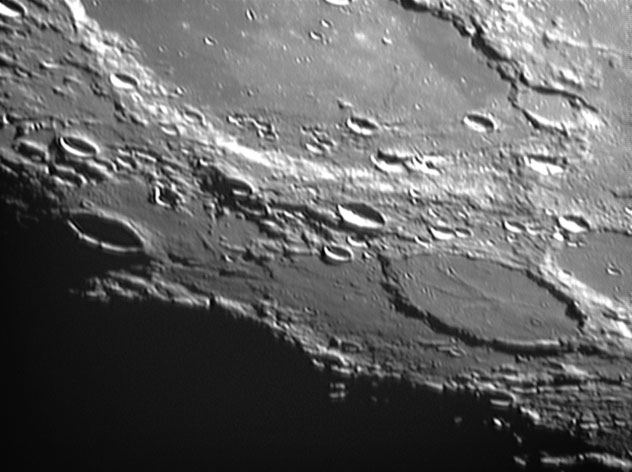|
 Wargentin
est une forme peu commune de cratère (85 km, 300m). L'intérieur a été
complètement rempli jusqu'au bord de sa muraille par un écoulement de lave,
de sorte qu'il forme un plateau au-dessus de la surface environnante. Quand
l'écoulement de lave s'est produit, a l’intérieur du cratère, elle s'est
accumulée jusqu'à déborder sur la plus basse partie de la muraille. Un
certain colmatage a alors empêché l'écoulement de lave de se déverser. La
muraille de Wargentin est légèrement érodée et recouverte par quelques
petits cratères. Des dorsales peuvent être discernées sur la surface,
rayonnant du centre du cratère. Wargentin est situé sur le limbe Sud-ouest
lunaire, de sorte qu'il semble ovale par pespective. Il est relié le long de
sa muraille Sud-est au cratère légèrement plus petit Nasmyth (77 km). Au
Nord-est le versant de Schickard est jointif avec celui de Wargentin.
Wargentin
est une forme peu commune de cratère (85 km, 300m). L'intérieur a été
complètement rempli jusqu'au bord de sa muraille par un écoulement de lave,
de sorte qu'il forme un plateau au-dessus de la surface environnante. Quand
l'écoulement de lave s'est produit, a l’intérieur du cratère, elle s'est
accumulée jusqu'à déborder sur la plus basse partie de la muraille. Un
certain colmatage a alors empêché l'écoulement de lave de se déverser. La
muraille de Wargentin est légèrement érodée et recouverte par quelques
petits cratères. Des dorsales peuvent être discernées sur la surface,
rayonnant du centre du cratère. Wargentin est situé sur le limbe Sud-ouest
lunaire, de sorte qu'il semble ovale par pespective. Il est relié le long de
sa muraille Sud-est au cratère légèrement plus petit Nasmyth (77 km). Au
Nord-est le versant de Schickard est jointif avec celui de Wargentin.
 (English version,
Wikipedia copyright)
(English version,
Wikipedia copyright)
Wargentin
is an unusual form of lunar impact crater. The dark interior has been
completely filled up to the edge of its raised rim by a basaltic lava flow,
so that it forms a raised plateau above the surroundings. When the lava flow
occurred, it erupted from within the crater walls and proceeded to
accumulate until overrunning the lowest portion of the rim. Some blockage
then prevented the lava flow from returning to equilibrium.
The rim of Wargentin is somewhat worn and is overlain by a few small craters.
The outer wall climbs to a height of 0.3 km above the surrounding terrain. A
spoked pattern of wrinkle ridges can be discerned on the surface, radiating
from the center of the crater.
Wargentin is located on the approaches to the southwest lunar, so that it
appears elongated when viewed from the Earth. It is connected along the
southeast rim to the slightly smaller Nasmyth crater, which is in turn
overlaid by the larger Phocylides crater. To the northeast is the much
larger Schickard walled-plain.
|
|



 (English version,
(English version,
